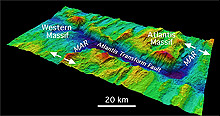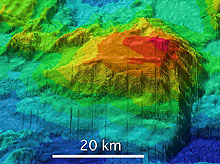
Perspective view of several massifs along the Atlantis Transform Fault. The Atlantis Massif, at the MAR intersection is about 2 m.y. old. The Western Massif is about 10 m.y. old. Shallow (red) areas reach <1000 m depth; deep (purple) areas reach >6000 m. Click image for larger view and image credit. (HR)
The Western Massif
July 23, 2005
Dr. Jeff Karson
Geologist
Duke University
NOAA ship Ronald H. Brown arrived at our first study site last night and the first order of business was to collect new bathymetric data over the area. Our target is a large, dome-like mountain, referred to as the Western Massif, located about 100 km to the west of the Atlantis Massif where the Lost City Hydrothermal Field is located. Since the discovery of the Lost City our team has speculated that there could be other similar vent sites in similar settings, but this is the first time an expedition has had a chance to explore another massif.

Perspective view of the Western Massif. Steep cliffs on the south-facing wall will be the site of the first Hercules dives. Note similarities with the Atlantis Massif. Click image for larger view and image credit. (HR)
From the bathymetric map, one can see that there are many high-standing massifs similar to the Atlantis Massif strung out along the Atlantis Transform Fault. The Atlantis Massif is at the lithosphere plate corner bounded by the Mid-Atlantic Ridge spreading center and the transform. The massifs along the northern side of the transform were all created by seafloor spreading at this corner and then carried along westward as new seafloor was made at the spreading center. The lithosphere at the Western Massif is about 12 million years old. This is much older and probably colder than the Atlantis Massif, so we do not know if it will have hydrothermal vents. In many ways the two massifs are very similar. They are both about 20 km across and a few thousand meters high. They both have corrugated, broadly arched upper surfaces that are thought to make large fault surfaces. The southern edges of the massifs that face the transform fault are very steep and deeply scarred by mass wasting. If the Western Massifs geology is similar to the Atlantis Massif, we would expect to find a low-angle fault zone near the top of the south wall and steep faults that control hydrothermal venting.
No one has ever visited the Western Massif before so we do not know what we will find there. After our surprise discovery of the Lost City in 2000, we are not making any assumptions. We will use our experience with the Atlantis Massif to guide our investigation. We think that finding steep fault zones at the top of the southern wall of the massif will be the key to locating active or ancient hydrothermal sites. In our first dive, we will use Hercules to travel up the south wall and then along the top edge of the wall in search of these features.
Sign up for the Ocean Explorer E-mail Update List.


























